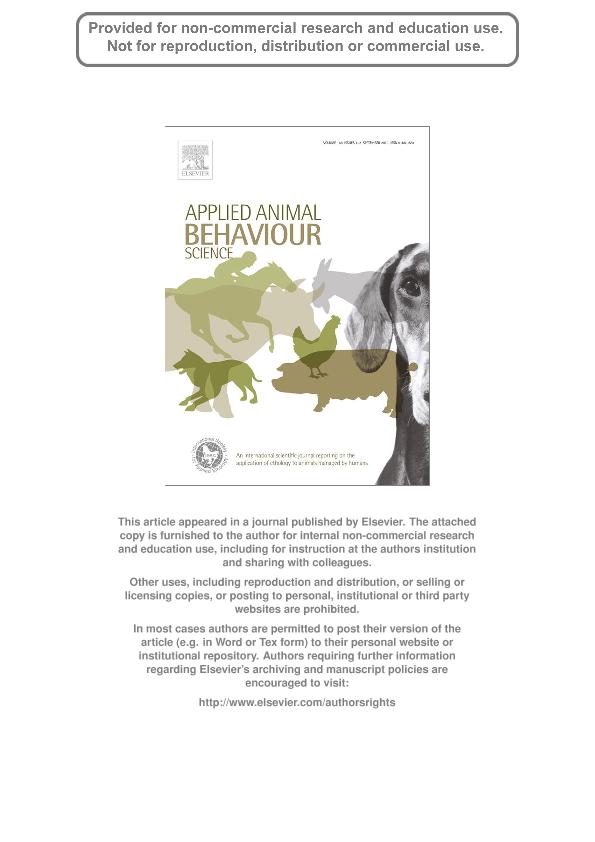Mostrar el registro sencillo del ítem
dc.contributor.author
Catanese, Francisco Hernan

dc.contributor.author
Obelar, Marianela
dc.contributor.author
Villalba, Juan Jose

dc.contributor.author
Distel, Roberto Alejandro

dc.date.available
2017-02-08T20:46:05Z
dc.date.issued
2013-09
dc.identifier.citation
Catanese, Francisco Hernan; Obelar, Marianela; Villalba, Juan Jose; Distel, Roberto Alejandro; The importance of diet choice on stress-related responses by lambs; Elsevier Science; Applied Animal Behaviour Science; 148; 1-2; 9-2013; 37-45
dc.identifier.issn
0168-1591
dc.identifier.uri
http://hdl.handle.net/11336/12723
dc.description.abstract
Farm animals are commonly restricted to a reduced array of foods, like total mixed rations or pastures with low species diversity. Under these conditions, animals are less likely to satisfy their specific and changing nutrient requirements. In addition, foods and flavors eaten too frequently or in excess induce sensory-specific satiety and can cause aversions. Thus, sensory and postingestive monotony may reduce animal welfare. We hypothesized that exposure to monotonous diets, even if they are considered to be nutritionally balanced, is stressful for sheep. Twenty-four 2-month-old male Corriedale lambs were randomly assigned to two experimental groups. One group (diversity treatment, DIV) received a free choice of four-way combinations of two foods with low and two foods with high protein/energy ratios from an array of seven foods (three foods high in protein/energy ratio: soybean meal, sunflower meal, and alfalfa pellets, and four foods low in protein/energy ratio: barley grain, oat grain, milo grain, and corn grain). The other group (monotony treatment, MON) was fed a balanced ration containing all foods offered to lambs in DIV. Foods were offered in four individual buckets and exposure lasted 55 days. During exposure, feeding behavior was assessed, and blood samples were taken for a complete blood cell count and to determine serum cortisol concentration. Lambs in MON showed greater cortisol levels (31.44 vs. 19.90 ± 3.30 nmol/L [means ± SEM]; P = 0.025) and a greater neutrophil to lymphocyte ratio (0.37 vs. 0.26 ± 0.05; P = 0.044) than lambs in DIV. Lambs in DIV spent a lower proportion of time eating (0.38 vs. 0.49 ± 0.02; P < 0.001) and showed a greater intake rate (17.73 vs. 14.09 ± 1.26 g/min, P < 0.044) than lambs in MON. They also showed a greater proportion of time lying (0.44 vs. 0.36 ± 0.03; P = 0.049) and greater activity (0.047 vs. 0.035 ± 0.003; P = 0.003) than lambs in MON. However, final body weight and the average daily weight gain were not affected by treatment (P > 0.05). Our results showed that restricting lambs? dietary breadth produced changes in blood and behavioral parameters previously shown to be indicative of stress in sheep. The importance of incorporating food choice as an alternative practice to overcome stress associated to the traditional livestock feeding management is discussed.
dc.format
application/pdf
dc.language.iso
eng
dc.publisher
Elsevier Science

dc.rights
info:eu-repo/semantics/openAccess
dc.rights.uri
https://creativecommons.org/licenses/by-nc-nd/2.5/ar/
dc.subject
Diet Selection
dc.subject
Stress
dc.subject
Sheep
dc.subject
Cortisol
dc.subject
Animal Welfare
dc.subject.classification
Ganadería

dc.subject.classification
Producción Animal y Lechería

dc.subject.classification
CIENCIAS AGRÍCOLAS

dc.title
The importance of diet choice on stress-related responses by lambs
dc.type
info:eu-repo/semantics/article
dc.type
info:ar-repo/semantics/artículo
dc.type
info:eu-repo/semantics/publishedVersion
dc.date.updated
2016-12-01T19:40:25Z
dc.journal.volume
148
dc.journal.number
1-2
dc.journal.pagination
37-45
dc.journal.pais
Países Bajos

dc.journal.ciudad
Philadelphia
dc.description.fil
Fil: Catanese, Francisco Hernan. Universidad Nacional del Sur. Departamento de Agronomía; Argentina. Consejo Nacional de Investigaciones Científicas y Técnicas. Centro Científico Tecnológico Bahía Blanca. Centro de Recursos Naturales Renovables de la Zona Semiárida(i); Argentina
dc.description.fil
Fil: Obelar, Marianela. Universidad Nacional del Sur. Departamento de Agronomía; Argentina. Consejo Nacional de Investigaciones Científicas y Técnicas. Centro Científico Tecnológico Bahía Blanca. Centro de Recursos Naturales Renovables de la Zona Semiárida(i); Argentina
dc.description.fil
Fil: Villalba, Juan Jose. State University Of Utah; Estados Unidos
dc.description.fil
Fil: Distel, Roberto Alejandro. Universidad Nacional del Sur. Departamento de Agronomía; Argentina. Consejo Nacional de Investigaciones Científicas y Técnicas. Centro Científico Tecnológico Bahía Blanca. Centro de Recursos Naturales Renovables de la Zona Semiárida(i); Argentina
dc.journal.title
Applied Animal Behaviour Science

dc.relation.alternativeid
info:eu-repo/semantics/altIdentifier/url/http://www.sciencedirect.com/science/article/pii/S0168159113001792
dc.relation.alternativeid
info:eu-repo/semantics/altIdentifier/doi/http://dx.doi.org/10.1016/j.applanim.2013.07.005
Archivos asociados
